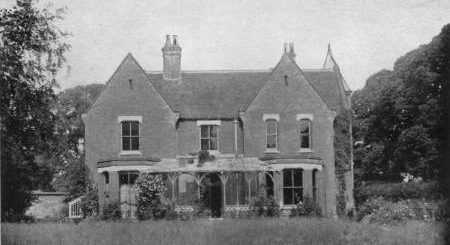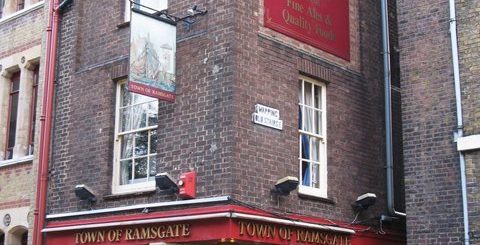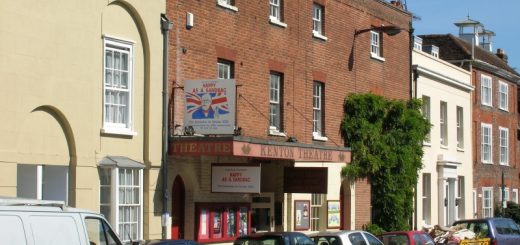Wem Rekindled by Andrew Homer
Andrew Homer was involved in the Wem Town Hall “Girl in the flames” photographic anomaly right from when the story broke in 1995. He was one of the few ASSAP investigators to actually meet with the photographer, Tony O’Rahilly. In June 2011 he presented a lecture for ASSAP at St Briavels Castle finally revealing the full story of this enduring case.
On the 19th November 1995, the old Wem town hall was burned to the ground. Amongst the crowds gathered that night to watch was amateur photographer, Tony O’Rahilly. One of the photographs, taken on black and white film with his 200mm lens, appeared to show a young girl standing in the doorway to the fire escape of the fiercely burning building. Since then, the Wem “Girl in the flames” picture (Figure 1 – Click Image) has become one of the best known and widely published ghost photographs ever taken.
The picture very quickly became linked with the story of Jane Churm who, in March 1677, allegedly started a great fire in Wem with a candle. Whilst collecting some stored wood for the fire, the fourteen year old girl placed her candle too close to the thatched roof. The roof caught fire and many buildings in Wem, including the Market House, were completely destroyed. The fire was said to have been visible for many miles around. Since then, local legend associated her guilt ridden ghost with the old Wem Town Hall and she was reputedly seen on a number of occasions. One such incident involved two workmen in the old hall doing some refurbishment work who reported being terrified by a ghostly figure shrouded in a swirling mist which passed directly in front of them.
Tony’s picture received extensive media coverage and ASSAP regional group, Parasearch, were first on the scene to investigate. Various experts were called on to give an opinion including Dr Vernon Harrison of ASSAP. He concluded that whilst the negative appeared not to have been tampered with, the figure was most likely burning debris which by chance appeared to look like a little girl. A classic case of Pareidolia in fact. Dr Harrison did suggest that, “it could be a burning plank of wood though” (Topham).
A BBC programme made at the time had a copy of the photograph analysed by experts at the National Museum of Photography, Film, and Television in Bradford (now the National Media Museum). Paul Thompson and Will Stapp concluded that the image had been manipulated. Indeed, Thompson detected what he thought were scan lines, “as though the image consisted of a photo of a face on a video screen pasted into the picture of the fire” (Smith 2010).
 It has to be said that there were no witnesses to the girl being in the flames including Tony himself who claimed he only discovered her presence when he developed the film. The fire service recorded a video of the blaze and this too showed no sign of the little girl or indeed the burning debris which could have created the illusion according to Dr Harrison.
It has to be said that there were no witnesses to the girl being in the flames including Tony himself who claimed he only discovered her presence when he developed the film. The fire service recorded a video of the blaze and this too showed no sign of the little girl or indeed the burning debris which could have created the illusion according to Dr Harrison.
The author met with Tony O’Rahilly at the time who maintained that he was as curious as anyone as to how the girl had come to appear on his picture. For this reason he was more than willing for the original negative to be examined by experts which is how Dr Harrison got involved. Tony had a little darkroom set up in a shed behind his house and did all of his own developing and printing there. One slightly odd aspect was that Tony claimed he could not find any of the negatives preceding or following the image of the girl which had been cut out from the rest of the strip. Preceding and following exposures from the same negative strip of the town hall burning down would have helped to authenticate the image. Tony did have other pictures of the burning building however, including the one reproduced here (Figure 2 – Click Image) which is previously unpublished. As with the fire service video there is no indication of burning debris creating any kind of illusion. Various other theories were put forward but for the most part the picture has remained something of a mystery.
 In 2007 Steve Potter, a digital photography specialist, examined my own high quality JPEG image which had been taken directly from the original negative by the Shropshire Star in 1995. Steve noted a denser area behind the figure that could have been due to, “a thicker area of the original negative” (Figure 3 – Click Image). He concluded that, “this image could be a selective enlargement which then was re-touched either on the print or by using an interneg of the figure being sandwiched between the original negative or even a copy negative”. A negative created from a manipulated photograph in other words. However, Steve was able to discount the scan line theory finding that, “the lines on the print do not suggest scan lines of an image photographed from a television screen but scratch lines made by dust and dirt in the camera’s back, a common problem in 35mm cameras”. It has to be noted that Steve had access to digital image analysis techniques simply not available to the experts, including Dr Harrison, who were consulted in 1995.
In 2007 Steve Potter, a digital photography specialist, examined my own high quality JPEG image which had been taken directly from the original negative by the Shropshire Star in 1995. Steve noted a denser area behind the figure that could have been due to, “a thicker area of the original negative” (Figure 3 – Click Image). He concluded that, “this image could be a selective enlargement which then was re-touched either on the print or by using an interneg of the figure being sandwiched between the original negative or even a copy negative”. A negative created from a manipulated photograph in other words. However, Steve was able to discount the scan line theory finding that, “the lines on the print do not suggest scan lines of an image photographed from a television screen but scratch lines made by dust and dirt in the camera’s back, a common problem in 35mm cameras”. It has to be noted that Steve had access to digital image analysis techniques simply not available to the experts, including Dr Harrison, who were consulted in 1995.
 The story now moves to the 17th May 2010, when a report by Toby Neal (2010) appeared in a local newspaper, the Shropshire Star. A retired engineer, Brian Lear, had spotted a little girl bearing a striking resemblance to the girl in the flames on a postcard of Wem High Street dating from 1922 (Figure 4 – Click Image). She can be seen standing in a doorway on the bottom left hand side of the postcard.
The story now moves to the 17th May 2010, when a report by Toby Neal (2010) appeared in a local newspaper, the Shropshire Star. A retired engineer, Brian Lear, had spotted a little girl bearing a striking resemblance to the girl in the flames on a postcard of Wem High Street dating from 1922 (Figure 4 – Click Image). She can be seen standing in a doorway on the bottom left hand side of the postcard.
 Closer analysis of both images side by side (Figure 5 – Click Image) reveals that the folds in her bonnet and dress are identical as is the narrow sash she is wearing around her waist. The little girl’s right hand and thumb is also clearly visible in both images. There can be little doubt that this is the source of the picture which has intrigued so many people for so long. Tony O’Rahilly sadly passed away in 2005 but having met and talked with him I am convinced he believed he was, “acting in the best interests of Wem by bringing the town hall fire and the story of Jane Churm to the attention of the world’s media” (Homer, 2012).
Closer analysis of both images side by side (Figure 5 – Click Image) reveals that the folds in her bonnet and dress are identical as is the narrow sash she is wearing around her waist. The little girl’s right hand and thumb is also clearly visible in both images. There can be little doubt that this is the source of the picture which has intrigued so many people for so long. Tony O’Rahilly sadly passed away in 2005 but having met and talked with him I am convinced he believed he was, “acting in the best interests of Wem by bringing the town hall fire and the story of Jane Churm to the attention of the world’s media” (Homer, 2012).
 Having always maintained he was a very amateur photographer, the other picture he gave me at the time holds an interesting additional clue. A small advertising sticker on the back (Figure 6 – Click Image) suggests he was a bit more than the amateur photographer he claimed to be and more than capable of producing copies of photographs. The very technique required to create an interneg and thereby produce his enigmatic picture. I like to think Tony was trying to tell me something!
Having always maintained he was a very amateur photographer, the other picture he gave me at the time holds an interesting additional clue. A small advertising sticker on the back (Figure 6 – Click Image) suggests he was a bit more than the amateur photographer he claimed to be and more than capable of producing copies of photographs. The very technique required to create an interneg and thereby produce his enigmatic picture. I like to think Tony was trying to tell me something!
Images
Figure 1. Wem Town Hall “Girl in the flames”. Copyright Tony O’Rahilly and published by kind permission of the Fortean Picture Library.
Figure 2. Previously unpublished picture taken from the same location by Tony O’Rahilly.
Figure 3. Portion of original photograph illustrating denser area identified by Steve Potter.
Figure 4. Postcard from 1922 discovered by Brian Lear.
Figure 5. Side by side comparison of the two images.
Figure 6. Tony O’Rahilly’s advertising sticker.
References
Homer, A (2012). Haunted Hostelries of Shropshire. Stroud: Amberley Publishing. pp. 147 – 149.
Neal, T. (2010). Does postcard solve ghost riddle? www.shropshirestar.com/news/2010/05/17/does-postcard-solve-ghost-riddle/. Accessed 27th November 2012.
Smith, B (2010) From the Edge of Postcards: The Wem Ghost Photo. www.csicop.org/si/show/from_the_edge_of_postcards_the_wem_ghost_photo/. Accessed 27th November 2012.
Topham, I. Wem Town Hall. www.mysteriousbritain.co.uk/england/shropshire/hauntings/wem-town-hall.html. Accessed 27th November 2012.





Recent Comments